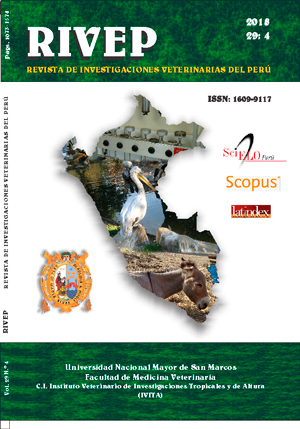Morphological characterization of the pancreas in newborns and foetuses of alpacas (Vicugna pacos) in the last third of gestation
DOI:
https://doi.org/10.15381/rivep.v29i4.15178Keywords:
alpaca, fetus, morphology, newborn, pancreasAbstract
The objective of this study was to identify and describe the macroscopic and microscopic characteristics of the anatomy of the pancreas of alpacas, both in the last third of the gestation and in the neonate (0-30 days). The study included three foetuses and 18 alpaca crias (0 days [3], 7 days [5], 15 days [5], and 30 days [5]). In the macroscopic analysis, the pancreas was observed in situ, including its ducts and its relationship with other organs, taking biometric measures (body length, height at withers, thoracic perimeter, and abdominal perimeter), as well as the weight of the individuals. Macroscopically, the pancreas is alike to that of adult alpacas. Microscopically, the pancreas presents a definite cellular cytoarchitecture, formed by tubular acinar of acidophilic cytoplasm, elongated of basal nuclei and irregular islets (in size and shape), as well as undifferentiated cell groups. This cytoarchitecture varies in the first week of age, where the conformation of acini and islets is irregular, presenting a high rate of cell division and a great number of precursor cells distributed throughout the field. The cellular activity diminishes with the age, being found in the animals of 30 days a cytoarchitecture quite alike to the one of the adult alpacas.Downloads
Downloads
Published
Issue
Section
License
Copyright (c) 2018 Franck Casanova V., Alexander Chávez R., Miluska Navarrete Z., Nieves Sandoval C., Alberto Sato S., Francisco Santos R.

This work is licensed under a Creative Commons Attribution-NonCommercial-ShareAlike 4.0 International License.
AUTHORS RETAIN THEIR RIGHTS:
a. Authors retain their trade mark rights and patent, and also on any process or procedure described in the article.
b. Authors retain their right to share, copy, distribute, perform and publicly communicate their article (eg, to place their article in an institutional repository or publish it in a book), with an acknowledgment of its initial publication in the Revista de Investigaciones Veterinarias del Perú (RIVEP).
c. Authors retain theirs right to make a subsequent publication of their work, to use the article or any part thereof (eg a compilation of his papers, lecture notes, thesis, or a book), always indicating the source of publication (the originator of the work, journal, volume, number and date).










